
The golden-mantled ground squirrel is a ground squirrel native to western North America. It is distributed in the Rocky Mountains of British Columbia and Alberta, and through much of the western United States.

Scincella lateralis, formerly Lygosoma laterale is a small species of skink found throughout much of the eastern half of the United States, and into northern Mexico. The ground skink differs from the majority of North American lizard species in that it is generally considered a forest dweller. Common names for this species include the little brown skink and the ground skink. However, the common name, ground skink, may refer to any species in the genus Scincella.
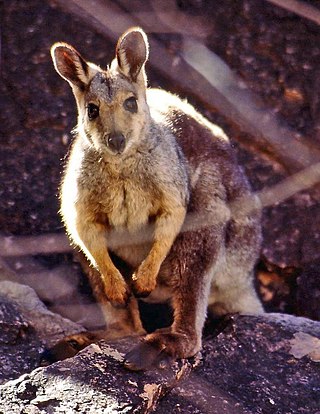
The black-flanked rock-wallaby, also known as the black-footed rock-wallaby or warru, is a species of wallaby, one of several rock-wallabies in the genus Petrogale. A shy, nocturnal herbivore, its two main subspecies are found in mostly isolated populations across western and southern Western Australia (WA), the Northern Territory and parts of South Australia (SA). With some subspecies showing a decline in populations in recent years, the whole species is classed as an endangered species under the Commonwealth EPBC Act.
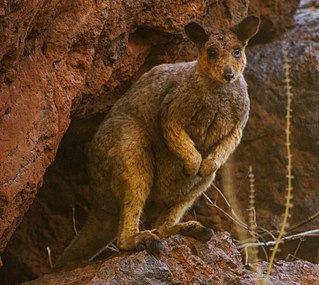
Rothschild's rock-wallaby – sometimes known as the Roebourne rock-wallaby, is a species of macropod found in Western Australia, in the Pilbara district and the Dampier Archipelago. It is not currently considered to be threatened, but is at risk from the red fox.

The whistling cisticola is a species of bird in the Cisticolidae family. It can be found in several regions within Africa, such as Angola, Benin, Burundi, Cameroon, Central African Republic, Republic of the Congo, Ivory Coast, Gabon, Gambia, Ghana, Guinea, Kenya, Liberia, Mali, Nigeria, Senegal, Sierra Leone, Sudan, Togo, Uganda, and Zambia. Its natural habitats include subtropical or tropical dry forests, dry savanna, and moist savanna.
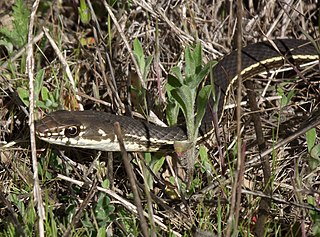
The California whipsnake, also known as the striped racer, is a colubrid snake found in habitats of the coast, desert, and foothills of California.

Mulinia lateralis, the dwarf surf clam or coot clam, is a species of small saltwater clam, a bivalve mollusc in the family Mactridae. It occurs in the western Atlantic Ocean and the Caribbean Sea.

The carpet chameleon, also known as the jewel chameleon or white-lined chameleon, is a species of chameleon that is endemic to eastern Madagascar. It is a relatively small chameleon and especially females tend to have bright markings in many colours, whereas males are mostly green and whitish or green and yellowish.
Nysson lateralis is a species of wasp in the family Crabronidae. It is found in North America.

Tettigidea lateralis, known generally as black-sided pygmy grasshopper, is a species of pygmy grasshopper in the family Tetrigidae. Other common names include the black-sided grouse locust and sedge grouse locust. It is found in the Caribbean Sea, North America, and parts of Central America.
Brachycentrus lateralis is a species of humpless casemaker caddisfly in the family Brachycentridae. It is found in North America.
Lopidea lateralis is a species of plant bug in the family Miridae. It is found in North America.
Chrysobothris lateralis is a species of metallic wood-boring beetle in the family Buprestidae. It is found in Central America and North America.

Sweltsa lateralis, the curved sallfly, is a species of green stonefly in the family Chloroperlidae. It is found in North America.
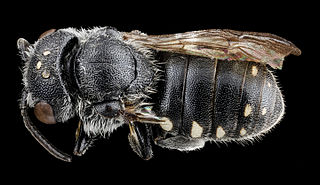
Stelis lateralis is a species of cuckoo bee in the family Megachilidae. It is found in Central America and North America.
Corimelaena lateralis is a species of ebony bug in the family Thyreocoridae. It is found in Central America and North America.
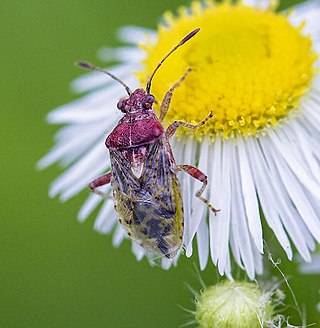
Arhyssus lateralis is a species of scentless plant bug in the family Rhopalidae. It is found in Central America and North America.

Cercyon lateralis is a species of water scavenger beetle in the family Hydrophilidae. It is found in North America and Europe.
Hyperaspis lateralis, the lateral lady beetle, is a species of lady beetle in the family Coccinellidae. It is found in Central America and North America.
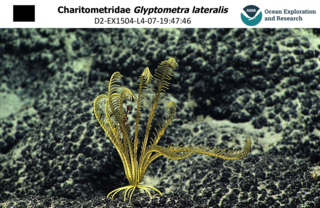
Glyptometra lateralis is a species of crinoid within the family Charitometridae. The species is found off Niihau at depths of 583 to 824 meters below sea level, although some individuals have been found as deep as 1748 meters.













